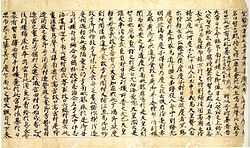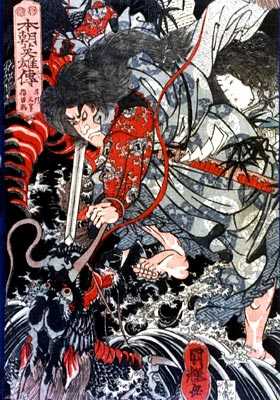Fudoki
| Part of a series on |
| Shinto |
|---|
 |
| Practices and beliefs |
| Shinto shrines |
|
| Notable Kami |
| Important literature |
| See also |
|
| Shinto portal |
Fudoki (風土記) are ancient records of provincial culture, geography, and oral tradition presented to reigning monarchs of Japan, also known as local gazetteers. They contain agricultural, geographical, historical and mythological records, as well as folklore. [1] Fudoki manuscripts also document local myths, rituals, and poems that are not mentioned in the Kojiki and the Nihon Shoki chronicles, which are the most important literature of the ancient national mythology and history. In the course of national unification, the imperial court enacted a series of criminal and administrative codes called ritsuryō and surveyed the provinces established by such laws to exert greater control over them.[2]
Kofudoki

In the narrower sense, Fudoki refer to the oldest records called Kofudoki (古風土記) written in the Nara period. Compilation of Kofudoki began in 713 and was completed over a 20-year period.[1] Following the Taika Reform in 646 and the Code of Taihō enacted in 701, there was need to centralize and solidify the power of the imperial court. This included accounting for lands under its control. According to the Shoku Nihongi, Empress Gemmei issued a decree in 713 ordering each provincial government (ja:国衙 kokuga) to collect and report the following information:[1][3]
- Names of districts and townships
- Natural resources and living things
- Land fertility
- Etymology of names for geographic features, such as mountains, plains, and rivers
- Myths, legends, and folktales told orally by old people
Names
A requirement of place names was that they had to be written with two kanji characters with positive connotations.[1] This occasionally required name changes. For example, Hayatsuhime (速津媛) became Hayami (速見) and Ishinashi no Oki (無石堡) became Ishii (石井).
Manuscripts
At least 48 of the Gokishichidō provinces contributed to their records but only that of Izumo remains nearly complete. Partial records of Hizen, Bungo, Harima and Hitachi remain and a few passages from various volumes remain scattered throughout various books.[1] Those of Harima and Hizen are designated National Treasures.
Below is a list of extant manuscripts and scattered passages.[4][5]
Kinai
Tōkaidō
Tōsandō
|
Hokurikudō
San'indō
San'yōdō
|
Nankaidō
Saikaidō
|
See also
Notes
- ↑ 1.0 1.1 1.2 1.3 1.4 Sakamoto 2011, pp. 16-17.
- ↑ Sakamoto 2011, pp. 4-5.
- ↑ Kojima et al. 2007, pp. 310-311.
- ↑ Sakamoto 2011, p. 19.
- ↑ 国土としての始原史~風土記逸文
References
- Akimoto, Kichirō (1958). Nihon Koten Bungaku Taikei 2: Fudoki. Tōkyō: Iwanami Shoten. ISBN 4-00-060002-8.
- Sakamoto, Masaru (2011). Zusetsu Chizu to Arasuji de Wakaru! Fudoki. Seishun Publishing. ISBN 978-4-413-04301-4.
- Kojima, Noriyuki; Naoki, Kōjirō; Nishimiya, Kazutami; Kuranaka, Susumu; Mōri, Masamori; Uegaki, Setsuya (2007). Nihon no Koten wo Yomu 3 Nihon Shoki Ge • Fudoki. Shogakukan. ISBN 978-4-09-362173-1.
External links
- 風土記(Big5 Chinese) texts of the remaining Fudoki & scattered passages in other books.
- Manuscript scans at Waseda University Library: Hizen, 1800,Bungo, 1800, Bungo, unknown
- Tsukamoto, Tetsuzō (塚本 哲三) (1915). Kojiki, Norito, Fudoki (古事記・祝詞・風土記). Yūhōdō Shoten (有朋堂書店). pp. 383–586. Scan on Internet Archive.
- 風土記 (Japanese)
- 国土としての始原史~風土記逸文 (Japanese)
| |||||||||||||||||||||||||||||||||||||||||||||

